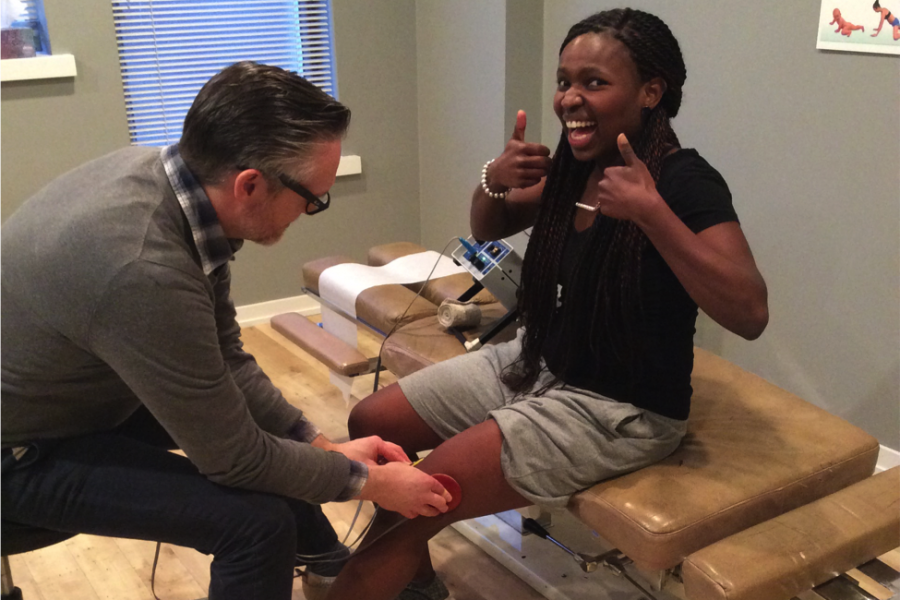
A Brief Introduction to My Co-op
Performance Health Group (PHG) is a chiropractic practice established in 2000. There are currently three locations: Vancouver, Aldergrove and Surrey. My co-op is situated at the heart of downtown Vancouver. It consists of four phenomenal and intelligent chiropractors, in addition to two Registered Massage Therapists (RMTs). The practitioners are amazing and passionate about what they do because every patient always leaves the clinic affirming how much better they feel or how they’ve improved.
My experience thus far has been an exponential learning curve. My mentor/supervisor sometimes jokes, “I am paying you to learn and gain experience”. When I began my practicum at PHG, I had succumbed to a great deal of societal ideologies (myths), which are the root cause of many patients’ back pain. No sooner had I began my co-op than the practitioners began to teach me otherwise. Over the past four months, my thought process (mental paradigm) has significantly changed with regards to daily practices and habits we embrace that are bad for our spine.
About 80 percent of the population suffers from a form of lower back pain at some point in their life. Exercises and learned habits (such as sit-ups and crunches in addition to sucking the gut in) are encouraged by the media, fitness trends and societal ideologies. These have helped fuel flawed movements in our lifestyle and everyday occupational movement patterns, which results in back injury and pain.
Similar to oral hygiene where we perform daily activities such as brushing or flossing to prevent cavity formation; spinal hygiene refers to the daily maintenance of one’s back to prevent spinal injuries or dysfunction.
In order to successfully alleviate or reduce back pain, the focus should be on eliminating movement flaws that cause stress on the spine and surrounding tissues. (McGill, 2015) In what follows, I will shed light on three common myths about some of the causes of back pain as well as provide some basic home care recommendations for maintaining good spine hygiene.
Myth 1: Core Stability ≠ Core Strength
The media, fitness professionals and societal perceptions dictate that having a strong core is the ultimate key to a pain free back. While a strong core is definitely important, it’s not a strong core that matters: it is solid control and endurance of the supporting or stabilizing muscles that is important for maintaining a healthy back. If the former was the case, all the elite athletes and fitness gurus would never experience back pain!
As a result, many individuals focus on core workouts that involve constantly bending the spine, such as sit ups and crunches. Constantly bending and flexing your lower back during these exercises puts compressive pressure on the spinal discs (which act as a cushion and protect the spine). The repeated bending action will eventually cause discogenic pain that may progress to stress exerted on nerves that stem from the lumbar and sacral spine. As a result, you can experience burning or tingling sensations and/or shooting pain down the lower body, commonly referred to as sciatica.
Myth 2: Suck Your Belly in to Keep That Core Tight!
You have all probably been told by a trainer or otherwise to “Suck in your stomach to activate the core” during general workouts or in order to acquire a six-pack. Highly inaccurate!
Think of the air pressure of an upright pop can. The three-dimensional air-pressure inside the can enables it to stay upright and balanced. In contrast, a can that is dented on one side easily collapses because the air-pressure inside is now distributed unevenly and therefore the can is more prone to collapse.
Correspondingly, our spine works in the same manner. By sucking in your stomach, the internal abdominal pressure is not evenly distributed to stabilize the spine. As a result, we end up putting more pressure on the spine. More crushing load exerted on the spine may result in disc related injuries such as a disc herniation, ruptured disc and other associated disc issues that present in the form of back pain.
Myth 3: Stretching is a Good Way to Alleviate the Pain
For all the yoga and Pilates lovers who believe that stretching is good for your back, think again! For those suffering from back pain, pulling your knees close to the chest may give a brief perception of pain relief (15-20 min) because of activation of the stretch sensors in your back muscles (erector spinae). By adopting this position, one is aggravating the spinal discs further and the pain returns, often worse than before! Notwithstanding, some patients do need to stretch if their back issue is a direct result of poor mobility or tightness. Though fewer people (than we think) are actually recommended to do so.
When I began at PHG, I had succumbed to all of the above myths. So far I have told you all how easy it is to wreck your backs as a result of practices that we have developed over time. The secret is not to sleep more, rest or stop working out, but to change default movement patterns so that you can enjoy the benefits without compromising your back!
Training the Core
Alternative, back-sparing exercises should be undertaken instead of those typical sit-ups and crunches traditionally associated with increasing core strength, but that cause a constant bending and compression of the spine. For those already experiencing some form of back pain, some corrective back and core exercises include the Curl-up, Bird dog and Side-Bridge (Plank). According to Dr. Stuart McGill (2015), these three exercises are collectively known as the ‘Big 3 exercises’. While these are not the only rehabilitative or corrective exercises one can perform, research shows their effectiveness in development of muscular strength while maintaining stability and control of the core and back muscles (McGill, 2015, p. 9).
Below, are Dr. McGill’s Big 3 exercises:
Diaphragmatic/Abdominal Breathing
According to Dr. Evans Osar (2012), “Breathing sets up the most fundamental corrective exercise for movement dysfunction and back pain. It sets up proper stabilization and optimal or ideal alignment of the spine, hip and shoulder joints!”
In contrast to ‘sucking in your belly to keep your core tight’, one of the fundamental corrective exercises that my mentor and chiropractors here at PHG have taught me and majority of their patients to perform is known as abdominal or diaphragmatic breathing. It allows for one to get that three-dimensional activation of the core and stabilizing muscles.
To do this: Simply push your index and middle fingers into your oblique muscles (about 5-12 cm from the navel) and slowly breathe in pushing out the fingers or a waist belt (if wearing one). This type of breathing allows you to stabilize and equilibrate the abdominal pressures and decompress the spine. Think of it as a creation of internal pressures that create outward stabilization (Osar, 2012).
These are among the few things that I am continually learning to do. Even I am sometimes still guilty of sucking in my gut (especially when I need those jeans or that dress to fit snugly) but I immediately correct this when I become aware of it. I have personally noticed tremendous improvement in my core endurance and back health by doing these simple adjustments and exercises.
Although the exercises I have discussed are basic movements, you must remember that one size does not fit all. Consult with your therapist if you experience pain or discomfort while performing these exercises.
Last but not least, many trainers and practitioners follow a ‘recipe’ for assessment, corrective exercise or performance training. From my co-op experience here, I have learnt that as a practitioner, recognizing the uniqueness of each patient’s diagnosis and adjusting treatment methods to suit each one is necessary to enhance the recovery process of your patient; a quality that is greatly embodied in the chiropractors and RMT’s approach at Performance Health Group clinic.
References
McGill, S. (2015). Back mechanic: the step by step McGill method to fix back pain. Waterloo, Ont: Backfitpro Inc.
Osar, Evan. (2012). Corrective Exercise Solutions to Common Movement Dysfunction of the Hip and Shoulder. Chinchester, UK: Lotus Publishing.














